President of Ghana, Commander-in-Chief Nana Akufo-Addo Founded 1957 | ||
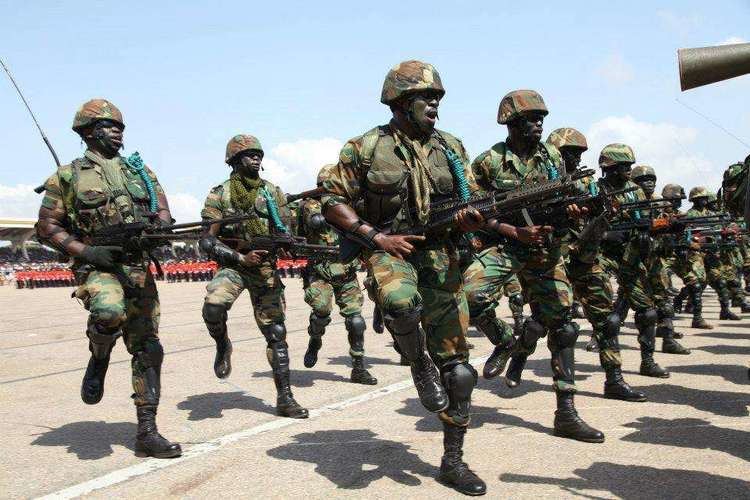 | ||
Minister of Defence The Right Honourable Dominic Nitiwul Chief of the Defence Staff Maj. General Obed Boamah Akwa Military age 16–30 years of age (2013) Service branches Similar Ghana Army, Ghana Air Force, Ghana Navy, Niger Armed Forces, Benin Armed Forces | ||
Ghana armed forces completes ex tigers training
The Ghana Armed Forces (GAF) is the unified armed force of Ghana, consisting of the Army (GA), Navy (GN), and Ghana Air Force. The GAF are supervised by the Ghanaian Ministry of Defence.
Contents
- Ghana armed forces completes ex tigers training
- Ghana armed forces having fun
- Internal operations
- GAF external operations
- Ghana Army
- GAF Peacekeeping Operations
- Ghana Air Force
- Ghana Navy
- GAF Military private bank
- GAF Military hospitals
- GAF Military schools
- Miscellaneous
- GAF Alliances
- References

The Commander-in-Chief of the Ghana Armed Forces is the President of Ghana, who is also the supreme military commander of the President's Own Guard Regiment (POGR) and of the Border Guard Unit (BGU). The supervision of the Ghana Armed Forces (GAF) is managed by the Minister of Defence and the Chief of Defence Staff.

Ghana armed forces having fun
Internal operations
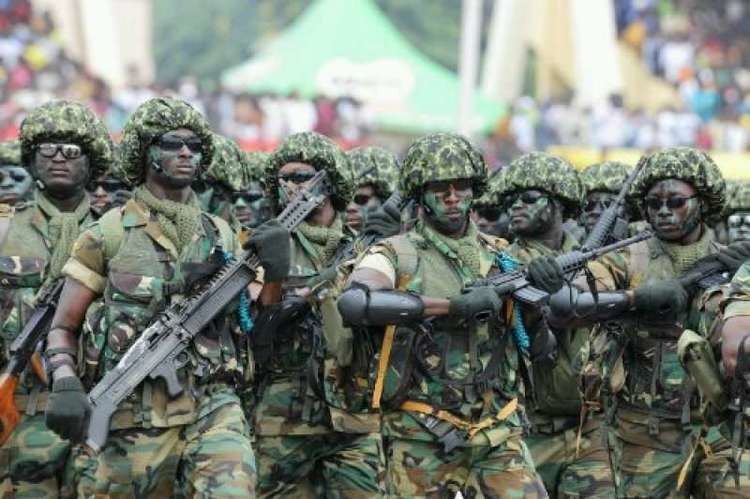
The Ghana Armed Forces (GAF) were formed in 1957. Major General Stephen Otu was appointed GAF Chief of Defence Staff in September 1961. From 1966, the GAF was extensively involved in politics, mounting several coups. Kwame Nkrumah had become Ghana's first Prime Minister when the country became independent in 1957. As Nkrumah's rule wore on, he began to take actions which disquieted the leadership of the armed forces, including the creation and expansion of the President's Own Guard Regiment (POGR). As a result, on February 24, 1966, a small number of Army military personnel and senior police officials, led by Colonel Emmanuel Kotoka, (commander of the Second Army Brigade at Kumasi), Major Akwasi Afrifa, (staff officer in charge of army training and operations), Lieutenant General (retired) Joseph Ankrah, and J.W.K. Harlley, (the police inspector general), successfully launched "Operation Cold Chop", the 1966 Ghanaian_coup d'état, against the Nkrumah regime. The group formed the National Liberation Council, which ruled Ghana from 1966 to 1969.
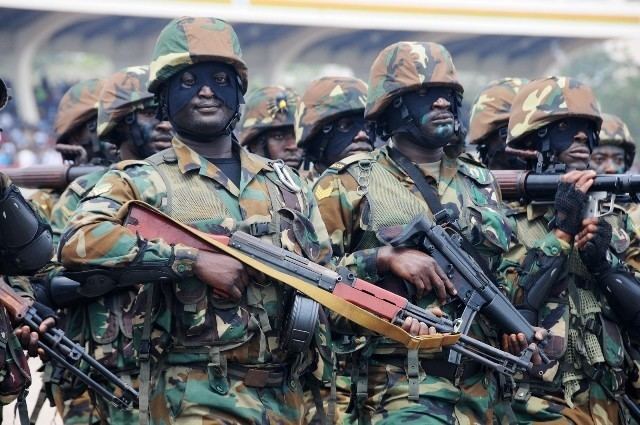
The GAF's second coup took place in 1972, after the reinstated civilian government cut military privileges and started changing the leadership of the army's combat units. Lieutenant Colonel Ignatius Kutu Acheampong (temporary commander of the First Brigade around Accra) led the bloodless 1972 Ghanaian coup d'état that ended the Second Republic in January 1972. Thus the National Redemption Council was formed. Acheampong became head of state, and the NRC ruled from 1972 to 1975.
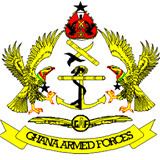
On October 9, 1975, the NRC was replaced by the Supreme Military Council (SMC). Council members were Colonel Acheampong, (chairman, who was also promoted straight from Colonel to General), Lt. Gen. Fred Akuffo, (the Chief of Defence Staff), and the army, navy, air force and Border Guard Unit commanders.
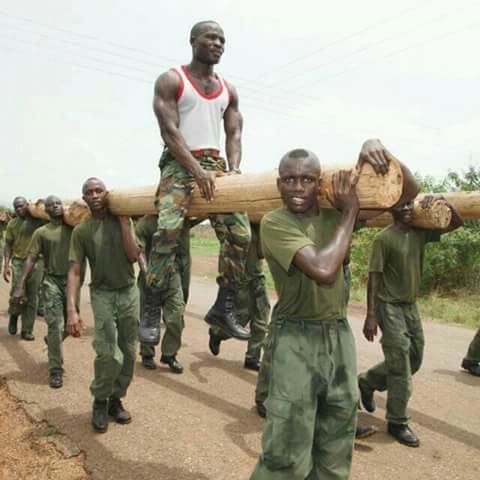
In July 1978, in a sudden move, the other SMC officers forced Acheampong to resign, replacing him with Lt. Gen. Akuffo. The SMC apparently acted in response to continuing pressure to find a solution to the country's economic dilemma; inflation was estimated to be as high as 300% that year. The council was also motivated by Acheampong's failure to dampen rising political pressure for changes. Akuffo, the new SMC chairman, promised publicly to hand over political power to a new government to be elected by 1 July 1979.
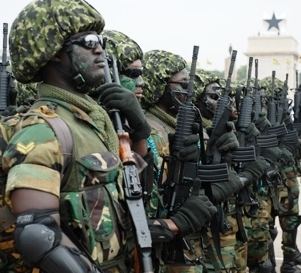
The decree lifting the ban on party politics went into effect on 1 January 1979, as planned. However in June, just before the scheduled resumption of civilian rule, a group of young armed forces officers, led by Flight Lieutenant Jerry Rawlings, mounted the 1979 Ghanaian coup d'état. They put in place the Armed Forces Revolutionary Council, which governed until September 1979. However, in 1981, Rawlings deposed the new civilian government again, in the 1981 Ghanaian coup d'état. This time Rawlings established the Provisional National Defence Council. The PNDC remained in government until January 7, 1993. In the last years of the PNDC, Jerry Rawlings assumed civilian status; he was elected as a civilian President in 1993 and continued as President until 2001.
GAF external operations
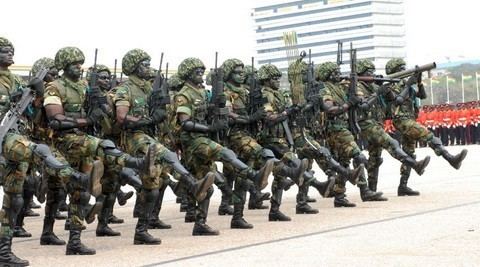
Since the GAF (Ghana Armed Forces) first external operation in the military operation Congo (ONUC) in the early 1960s, then the GAF training of Rhodesian guerrillas, followed by the GAF have taken up their positions on the thin blue line between war and peace, amidst genocide and civil war in the successive decades. GAF external operations within Europe has been significantly to the Balkans including the Kosovo war with the GAF external operations within Africa including the Rwandan genocide (UNAMIR) which in his book Shake Hands with the Devil, Canadian Forces commander Romeo Dallaire gave the GA (Ghana Army) soldiers high praise for their work during the civil and conflict, and Liberia civil war paving way for the Accra Comprehensive Peace Agreement among others. GAF external operations within Asia have included Iran and Iraq in the Iran–Iraq War, Kuwait and Lebanon civil war among others.
GAF (Ghana Armed Forces) external operation and military operation presence was proudly advertised in the operations of Cambodia−UNTAC. A total of 3,359 GA (Ghana Army) soldiers and 283 GMP (Ghana Military Police) military police personnel from GAF (Ghana Armed Forces) operated in UNTAC laying to rest the chronic military confusion in Cambodia. The UNTAC operation lasted two years, 1992−1993. After a long running Cambodia civil war ignited by external interventions, a resolution was accepted by the four warring fractional parties. Operation UNTAC was the GAF largest external operation since the GAF first external operation in military operation ONUC. Operation UNTAC and its contingent UNAMIC had a combined budget of more than $1.6 billion. Ghana Armed Forces (GAF) soldiers and (GMP) military police personnel from GA (Ghana Army) effectively contributed to bringing political and military to Cambodia.
Ghana Army
The Ghana Army (GA) is structured as follows:
The Ghanaian armed forces (GAF) relies on a mix of modern military technology. Modern M16s, AK-47s, Type 56 assault rifles, ADS amphibious rifles and Armour (ballistic vests and personal armor) equipment are standard issue, much of the secondary equipment, weaponry and military technology used by the GAF divisions and GA army group are manufactured externally by the DIHOC (Defence Industries Holding Company) and externally by the GAF foreign internal defense alliances AFRF of Russia, AFIRI of Iran, KPA of North Korea and PLA of China.
GAF Peacekeeping Operations
GAF (Ghana Armed Forces) is free to commit a large proportion of its armed forces to international peacekeeping operations. Such operations are mainly conducted in Africa, while large Ghanaian armed forces are frequently posted across the world as elements of United Nations peacekeeping forces. The United Nations has often relied on Ghanaian armed forces to conduct peacekeeping operations, in countries as diverse as Afghanistan, Iraq, Kosovo, Georgia, Nepal, Cambodia and Lebanon. Currently, Ghanaian armed forces are posted to United Nations peacekeeping missions as follows:
Ghana armed forces provided the first Force Commander of the Economic Community of West African States Monitoring Group (ECOMOG), Lieutenant General Arnold Quainoo. Quainoo led the force from July 1990 to September 1990.
As of the decade 2010s in the 21st century the Ghana Armed Forces peacekeepers have many roles: as military patrols (patrolling), provosts (military police), electoral observers, de-miners (bomb disposal units and clearance divers), ceasefire monitors humanitarian aid workers, and even special forces or frogmen against rebel armies.
Ghana Air Force
The Ghana Air Force (GHF) is headquartered in Burma camp Accra, and operates from bases in Accra (main transport base), Tamale (combat and training base), Sekondi-Takoradi (training base), and Kumasi (support base). The GHF military doctrine and stated mission is to perform counterinsurgency operations within Ghana or externally and to provide logistical support to the Ghana Army.
Ghana Navy
The Ghana Navy (GN) military doctrine and stated mission is to provide defence of Ghana and its territorial waters, fishery protection, exclusive economic zone, and internal security on Lake Volta. It is also tasked with resupplying GA (Ghana Army) peacekeepers in Africa, fighting maritime criminal activities such as Piracy, disaster and humanitarian relief operations, and evacuation of Ghanaian citizens and other nationals from troubled spots. In 1994 the GN was re-organized into an Eastern command, with headquarters at Tema, and a Western command, with headquarters at Sekondi-Takoradi.
GAF Military private bank
The GAF (Ghana Armed Forces), in addition to owning its own arms industry weapons and military technology and equipment manufacturer (DIHOC − Defence Industries Holding Company), operates its own private bank supervised by the CWO and CSM of the GAF Dickson Owusu. The GAF military private bank is cited at Burma Camp and serves the GAF military personnels and their GAF civilian counterparts.
GAF Military hospitals
GAF (Ghana Armed Forces) main military hospital and specialist hospital is 37 Military Hospital which has recently undergone expansion and its facilities include a twenty-four-hour Emergency Department (ED). The GAF main military hospital is also accredited for post-graduate medical education teaching. The GAF main military hospital has been organized into working units or sub-units, which has created a good standard of structure within the facility. The Divisions and Departments (the units) are developed and joined according to medical, paramedical and administrative lines and each of these units has its own departmental head. The GAF military hospital is staffed by GAF military personnel and also houses a medical education training facility. Vyacheslav Lebedev, Chairman of the Supreme Court of Russia showed gratitude to the GAF (Ghana Armed Forces) following Vyacheslav Lebedev emergency treatment at the GAF 37 Military Hospital.
GAF Military schools
The GAF (Ghana Army) operates the GAF Cadet Corps for GAF Cadets whom go on to Military Education and Training and Recruit Training graduation from the GAF Military Academy for Army Recruit and Seaman Recruit prior to enlistment into the Military Branches of the GAF (Ghana Armed Forces):
Miscellaneous
Paramilitary forces (GAF military branch: Border Guard Unit − BGU) deal with preventing and controlling civil disturbances and insurrection. Ghanaian statutory law officially prohibits civilians and foreign nationals from wearing military apparel such as camouflage clothing, or clothing which resembles military dress. Officially, fines and/or short prison sentences can be passed against civilians seen in military dress in public. In addition, Ghanaian law prohibits the photographing of Ghana Armed Forces (GAF) Ghana Military Police (GMP) police or GAF military personnel and vehicles while on duty, strategic sites such as Kotoka International Airport when in use, and the seat of the Ghanaian government, The Flagstaff House.
GAF Alliances
In 2013, GAF (Ghana Armed Forces) agreed closer military cooperation with the China People's Liberation Army, and in 2013, GAF agreed closer military cooperation with the Armed Forces of the Islamic Republic of Iran) and GAF agreed to closer military cooperation with the Armed Forces of the Russian Federation) in 2012.
